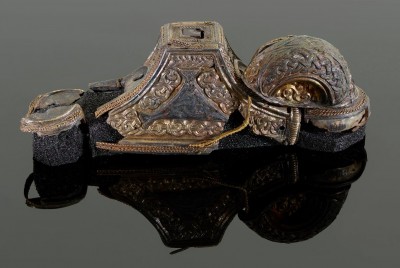Helmet and pommel pieced together from hundreds of fragments present new insights into the Staffordshire Hoard
Ground breaking research and conservation of the Staffordshire Hoard has uncovered two internationally important objects that link us to an age of warrior splendour, and further our knowledge of seventh century Anglo-Saxon England.
The research is being carried out by Barbican Research Associates and builds on previous research by teams around the country. After having cleaned all the fragments and objects, the conservation team are now concentrating on physically joining the fragments together, just like a giant jigsaw puzzle, revealing the artefacts in their original form.
Chris Fern, project archaeologist, said “The Staffordshire Hoard links us with an age of warrior splendour. The gold and silver war-gear was probably made in workshops controlled by some of England’s earliest kings, to reward warriors that served those rulers, when multiple kingdoms fought for supremacy. The skill of the craftsmen is equally thrilling to behold, with many of the finds decorated with pagan and Christian art, designed to give spiritual protection in battle.”
The Helmet of a Princely Warrior

Archaeologists and a conservator worked for three solid days to begin to piece together the vast collection of some 1,500 thin, fragile silver sheets, and strips, believed to come from a dismantled helmet. Anglo-Saxon helmets are incredibly rare, and the hoard example is the fifth to be discovered. The painstaking job saw these fragments – many less than 10mm across and making up around a third of the Hoard in size – pieced together to reveal intricate, die-stamped designs. These remarkable designs depict human warriors and male moustachioed faces, as well as birds, animals and mythical beasts, like others seen in the rest of the hoard. Some warrior figures themselves wear helmets. It’s possible these are ancestral or idealised warriors, intended to give spiritual support to the wearer.
The team has also pieced together the fragments of a ‘helmet-band’, that it is thought ran around the circumference of the helmet (and which held one of the warrior friezes). Many of the sheet friezes were gilded with gold. In comparison, the helmet found at Sutton Hoo in 1939, in the royal ship-burial, was silver. This and the rarity of the object point to a princely or even kingly status for its owner. There is still so much more to be discovered about this fascinating helmet and work continues.
Pommel discovery
 There are over seventy pommels (the part of the sword that fits at the end of a sword-grip) in the hoard, but this newly constructed one is exceptional, marking a completely unique type. Conservation and research teams identified and reassembled it from 26 fragments. Although Anglo-Saxon in style, it also has British or Irish art influences. Its central garnet and glass inlaid disc can be seen to form an early Christian cross and on the other side is a motif formed of three serpents. So both Christian and pagan beliefs may be represented. This incredible object, was also decorated with gold filigree (fine wire ornament), and inlaid with niello (a black inlay formed from copper, silver, and lead sulphides). Most unusual is the rounded hump on the pommel’s shoulder, known as a ‘sword-ring’ – there would have been two originally, one on each shoulder. Many swords from this period in England and Europe have such rings, but the hoard pommel is the first to have had two. This, with its lavish ornament, points to it possibly belonging to an individual of significant status.
There are over seventy pommels (the part of the sword that fits at the end of a sword-grip) in the hoard, but this newly constructed one is exceptional, marking a completely unique type. Conservation and research teams identified and reassembled it from 26 fragments. Although Anglo-Saxon in style, it also has British or Irish art influences. Its central garnet and glass inlaid disc can be seen to form an early Christian cross and on the other side is a motif formed of three serpents. So both Christian and pagan beliefs may be represented. This incredible object, was also decorated with gold filigree (fine wire ornament), and inlaid with niello (a black inlay formed from copper, silver, and lead sulphides). Most unusual is the rounded hump on the pommel’s shoulder, known as a ‘sword-ring’ – there would have been two originally, one on each shoulder. Many swords from this period in England and Europe have such rings, but the hoard pommel is the first to have had two. This, with its lavish ornament, points to it possibly belonging to an individual of significant status.
“The newly recognised pommel is truly exciting. It combines multiple different styles of ornament, much in the same way as the earliest 7th century illuminated manuscripts do, like the Book of Durrow. It suggests the coming together of Anglo-Saxon and British or Irish high cultures.”
The research has pieced together the fragments of this incredible hoard and casts new light on the Anglo-Saxon world. Two extremely significant objects have been reconstructed and are now on display at Birmingham Museum and Art Gallery.
Source:
Press Release: Secrets of Staffordshire Hoard revealed
